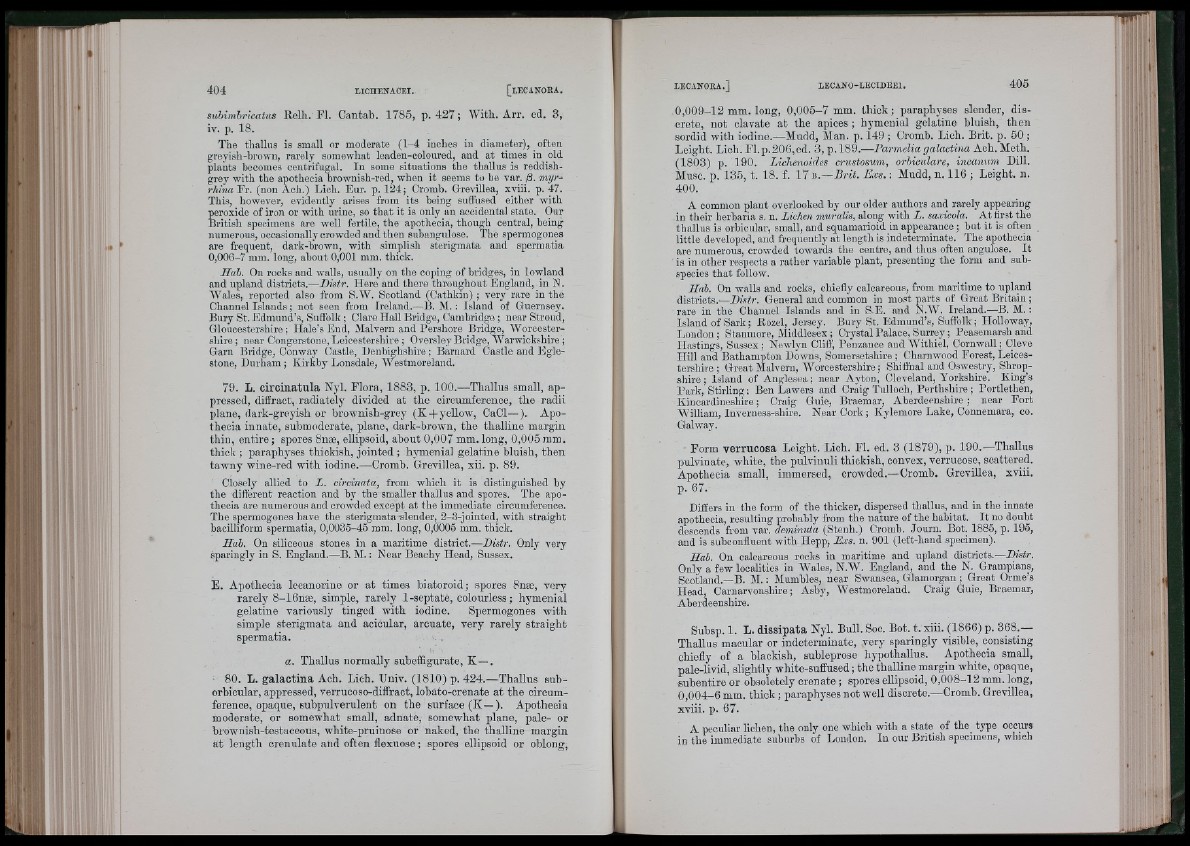
f
subimhrieatus Eelh. Pl. Cantab. 1785, p. 427 ; With. A rr. ed. 3,
iv. p. 18.
The thallua is small or moderate (1-4 inches in diameter), often
greyish-brown, rarely somewhat leaden-coloured, and at times in old
plants becomes centrifugal. In some situations the thallus is reddish-
grey with the apothecia brownish-red, when it seems to be var. ft. myr-
rhina Pr. (non Ach.) Lich. Eur. p. 124 ; Cromb. Grevillea, xviii. p. 47.
Thi.s, however, evidently arises from its being suffused either with
peroxide of iron or with urine, so th at it is only an accidental state. Our
British specimens are well fertile, the apotliecia, though central, being
numerous, occasionally crowded and then subangiilose. The spermogones
are frequeut, dark-brown, with simplish sterigmata and spermatia
0,006-7 mm. long, about 0,001 mm. thick.
Ilab. On rocks and walls, usually on the coping of bridges, in lowland
and upland districts.—Distr. Here and there throughout England, in N.
AVales, reported also from S.AV. Scotland (Cathkin) ; very rare in the
Channel Islands ; uot seen from Ireland.—È. M. ; Island of Guernsey.
Bury St. Edmund’s, Suffolk ; Clare Hall Bridge, Cambridge ; uear Stroud,
Gloucestershire ; Hale’s End, Alalvern and Pershore Bridge, Worcester-
sliire; near Congerstone, Leicestershire ; Oversley Bridge, AVarwickshire ;
Garn Bridge, Conway Castle, Denbighshire ; Barnard Castle and Eglestone,
Durham; Kirkby Lonsdale, AVestmoreland.
79. L. circinatula Nyl. Plora, 1883, p. 100.—Thallus small, appressed,
diffract, radiately divided a t the circumference, th e radii
plane, darli-greyish or brownish-grey (K + yeUow, CaCl—). Apothecia
in nate, submoderate, plane, dark-browu, th e th allin e margin
th in , entire ; spores 8iiæ, ellipsoid, about 0,007 mm. long, 0,005 ram.
thick ; paraphyses thiokish, jo in ted ; hymenial gelatine bluish, th en
taw n y wine-red with iodine.—Cromb. Grevillea, xii. p. 89.
Closely allied to Z. circinata, from which it is distinguished hy
the different reaction and by the smaller thallus and spores. The apothecia
are numerous and crowded except at the immediate circumference.
The spermogones have the sterigmata-slender, 2-8-jointed, with straight
bacilliform spermatia, 0,0035-45 mm. long, 0,0005 mm. thick.
Hab. On siliceous stones in a maritime district.—Distr. Only very
sparingly in S. England.—B. AI. ; Near Beachy Head, Sussex.
E. Apothecia lecanorine or a t times biatoroid; spores 8næ, very
ra re ly 8-16næ, simple, ra re ly 1 -septate, colourless : hymenial
gelatine variously tinged with iodine. Spermogones w ith
simple sterigmata and acioular, arcuate, very rarely stra ig h t
spermatia.
a. Thallus normally subelfig-urate, K —.
80. L. galactina Ach. Lich. Univ. (1810) p. 4 24.—Thallus sub-
orbicular, appressed, verrucoso-diffract, lobato-crenate a t th e circumference,
opaque, subpulverulent on th e surface (K —). Apotheoia
moderate, or somewhat small, adnate, somewhat plane, pale- or
brownish-testaceous, white-pruinose or naked, th e th allin e margin
a t length orenulate and often flexuose ; spores ellipsoid or oblong,
to i
0 ,0 0 9 -1 2 mm. long, 0 ,0 0 5 -7 mm. thiok ; paraphyses slender, d is crete,
no t clavate a t the apices ; hymenial gelatine bluish, th e n
sordid with iodine.—Aludd, Man. p. 149 ; Cromb. Lich. Brit. p. 50 ;
Leight. Lioh. F l.p .2 0 6 ,ed . 3, p. 189.— Parmelia g alactina Ach. Aleth.
(1803) p. 190. Lichenoides crustosum, orbiculare, incanum Dill.
Muso. p. 135, t. 18. f. 17 B.—B r it. E.vs. : Mudd, n. 116 ; Leight. n.
400.
A common plant overlooked by our older autliors and rarely appearing
in their herbaria s. n. Lichen muralis, along with L. saxicola. At first tho
thallus is orbicular, small, and squamarioid in appearance ; but it is often
little developed, and frequently at length is indeterminate. The apothecia
are numerous, crowded towards the centre, and thus often angulose. I t
is in other respects a rather variable plant, presenting the form and subspecies
that follow.
Hab. On walls and rocks, chiefly calcareous, from maritime to upland
districts.—Distr. General and common in most parts of Great Britain ;
rare in the Chanuel Islands and in S E. and N.AV. Ireland.—B. AI. :
Island of Sark ; Hozel, Jersey. Bnry St. Edmund’s, Suffolk ; Holloway,
Loudon ; Stanmore, Aliddlesex ; Crystal Palace, Surrey ; Peasemarsh and
Hastings, Sussex ; Newlyn Cliff, Penzance and AVithiel, Cornwall ; Cleve
Hill and Bathampton Downs, Somersetshire ; Charnwood Forest, Leicestershire
; Great Alalvern, AVorcestershire; Shiftnal and Oswestry, Shropshire
; Island of Anglesea ; near Ayton, Cleveland, Yorkshire. King’s
Park, Stirling ; Ben Lawers and Oraig Tulloch, Perthshire ; Portlethen,
Kincardineshire ; Craig Guie, Braemar, Aberdeenshire ; near Fort
AA’illiam, Inverness-shire. Near Cork ; Kylemore Lake, Connemara, co.
Galway.
Form verrucosa Leight. Lich. Fl. ed. 3 (1879), p. 1 9 0 .—Thallus
pulvinate, white, the pulvinuli thickish, convex, verrucose, scattered.
Apothecia small, immersed, crowded.—Cromb. Grevillea, xviii.
p. 67.
Differs in the form of the thicker, dispersed thallus, and in the innate
apothecia, resulting probably from the nature of the habitat. I t no douht
descends from var. deminuta (Stenh.) Cromb. Journ. Bot. 1885, p. 195,
and is subconfluent with Hepp, Exs. n. 901 (left-hand specimen).
Hab. On calcareous rocks in maritime and upland districts.—Distr.
Only a few localities in AVales, N.AV. England, and the N. Grampians,
Scotland.—B. AI. : Alumhles, near Swansea, Glamorgan ; Great Orme’s
Head, Carnarvonshire; Asby, AVestmoreland. Craig Guie, Braemar,
Aberdeeushire.
Subsp. 1. L. dissipata Nyl. Bull. Soo. Bot. t. xiii. (1866) p. 368.—
Thallus macular or indeterminate, very sparingly visible, consisting
chiefly of a blackish, suhleprose hypothallus. Apotheoia small,
pale-livid, slightly white-suffused ; the thaUine m argin white, opaque,
subentiro or obsoletely crenate ; spores ellipsoid, 0 ,0 0 8 -1 2 mm. long,
0 ,0 0 4 -6 mm. th ick ; paraphyses not well discrete.—Cromb. Grevillea,
xviii. p. 67.
A peculiar lichen, the only one which with a state of the^ type occurs
in the immediate suburbs of London. In our British specimens, which